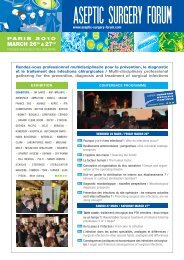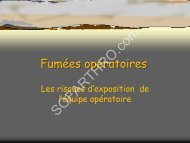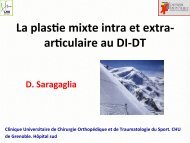Greffe du LCA et ostéotomie
Greffe du LCA et ostéotomie
Greffe du LCA et ostéotomie
- No tags were found...
You also want an ePaper? Increase the reach of your titles
YUMPU automatically turns print PDFs into web optimized ePapers that Google loves.
Arthrose<strong>et</strong>Laxités s <strong>du</strong> genouLibrement adapté d’undiaporama original<strong>du</strong> Pr C. Hul<strong>et</strong>
Expérimentalement:RelationconnueLa section <strong>du</strong> <strong>LCA</strong>(crânial) est unmodèle expérimentald’arthrose(chien, singe, moutonOegema TR, Visco D. Animal models ofosteoarthritis. . In Animal Models in orthopaedicresearch by YH An, RJ Friedman. CRC Press,Inc, Boca raton Florida LLC 1999 ; Chapitre 18 :349-67.Neyr<strong>et</strong>, ESSKA 2000Arthrose <strong>et</strong> <strong>LCA</strong> : Biomécanique
La "pr"préarthrose"Lésions chondrales en miroirSans os sous chondral à nuPrécède l’arthrose l(long)« Le genou instable tombe dans sacupule <strong>et</strong> devient douloureux »Arthrose <strong>et</strong> <strong>LCA</strong> : Histoire naturelle
L’arthroseAFTM 75 %AFT équilibrée 25 %Evolution en20 à 40 ansLeratArthrose <strong>et</strong> <strong>LCA</strong> : Histoire naturelle
3 Chapitres inégaux:1. <strong>LCA</strong> <strong>et</strong> arthrose,2. LCP <strong>et</strong> arthrose3. Lésionsbicroisés <strong>et</strong> arthrose
Arthrose <strong>et</strong> laxité antérieureTrillatLerat 1972Feagin 1976Jacobsen 1977Dejour Lerat 1979Mac Daniel 1980F<strong>et</strong>to 1980Levy 1982Imbert 1983Aubriot 1983Noyes 1983Marc 1984Paterson 1984Dupont 1986Neyr<strong>et</strong> 1987Dejour 1987Sherman 1988Lerat-Moyen 1989Noyes 1990Moyen 1993Ihara 1994Dejour 1995Locker 1995Saillant 1996Shelbourne 1997Vielpeau 1998Neyr<strong>et</strong> 1999Beaufils 2003Neyr<strong>et</strong> 2004Logan 2005Don Fithian 2005La plus fréquenteLittérature très s richePlus de 600 référencesrencesGenou droitLes laxités s ligamentaires anciennes post-traumatiques <strong>du</strong> genou. Résultats Rde358 interventions <strong>du</strong> service <strong>du</strong> Pr. A.TrillatJL. Lerat Thèse Médecine MLyon 1972RCOJBJSAOOGenou droitArthroscopyAnn. SFAConf EnseignementAJSMArthrose <strong>et</strong> <strong>LCA</strong>
Histoire naturelle:Evolution multifactorielleLésion <strong>du</strong> <strong>LCA</strong>LésionsméniscalesLésionscartilagineusesLésions périph. pLigamentairesMéniscectomieInstabilitéDouleurFacteursassociésBiologiquesCliniquesIatrogènesArthroseArthrose <strong>et</strong> <strong>LCA</strong> : Histoire naturelle
Histoire naturelleNebelung W. Thirty five years follow-upof anterior cruciateligament dficient knee in high level athl<strong>et</strong>es. Arthroscopy200510 ans79 % méniscectomie68 % MM, 37 % ML20 ans95 % méniscectomie68% lésion cart Grade IV100 % symptomatiques35 ans65 % PTG19 ruptures <strong>du</strong> lcaTtt conservateur1965197519852000N = 19 athlètesArthrose <strong>et</strong> <strong>LCA</strong> : Histoire naturelle
Eléments d’explications:dfacteurs biomécaniqueslésions associéesfacteurs liés s aux patientsfacteurs morphologiquesfacteurs chirurgicaux
Modifications biomécaniques:
3 Freins à la translation antérieure <strong>du</strong> tibia1.<strong>LCA</strong>2.MM3.PenteTibialeBurdinArthrose <strong>et</strong> <strong>LCA</strong> : Biomécanique
Rupture <strong>LCA</strong>= augmentationTranslation tibiale antérieureIn vivo,IRM dynamique, 3DIncompl<strong>et</strong> !Normal<strong>LCA</strong> rompu<strong>Greffe</strong> <strong>LCA</strong>Compartiment médial <strong>et</strong> latéralLogan, …& Freeman AJSM 2004Arthrose <strong>et</strong> <strong>LCA</strong> : Biomécanique
2. Segment postérieur <strong>du</strong> MMS’oppose à la translation tibant en ampVulnérabilitéFréquence des lésionsRôle de CaleMLMMBurdinLeratArthrose <strong>et</strong> <strong>LCA</strong> : Biomécanique
2. Importance des ménisques m(MM)In vitro, Levy (JBJS, 1982)AP Displacement (mm)At 100 newton force252015105021,8 22,319,7181714,717,416,611,4 <strong>LCA</strong>13,610,44,35,95,40° 30° 60° 90°<strong>LCA</strong> + MM<strong>LCA</strong> + ML14NORMAL4,8Arthrose <strong>et</strong> <strong>LCA</strong> : Biomécanique
2. Importance des ménisques m(MM)Neyr<strong>et</strong> (SFA 99)In vivo, subluxation active en AMPMesure différentielle en RXGenou normal : 3,4 + 2,9 mm<strong>LCA</strong> isolé : 5,6 + 5,8 mm<strong>LCA</strong> + mén. . méd. m: 7,2 + 4,4 mm !!Arthrose <strong>et</strong> <strong>LCA</strong> : Biomécanique
3. La pente tibialeBonnin M, Carr<strong>et</strong> JP,Dimn<strong>et</strong> J, Dejour H.JBJS 93.°Relation directe pente tibiale post. <strong>et</strong> translation tib. ant.Si PT de 5°Si PT de 10°La TTA augmente de 3 mmLa TTA augmente de 6 mmArthrose <strong>et</strong> <strong>LCA</strong> : Biomécanique
3. La pente tibialeSi la pente tibiale augmente :1. Augmente TTA (7,2 mm à 30° flexion)2. Elévation antérieure de 4,1 mm en ext.3. Augmentation contraintes FT 700 Nen ext. (100 N normalt)4. Déplacement point contact FTd’arrière en avant (passe de 61,4 % APà 25,4 %)BurdinAgneskirchner JD, Hurschler C, Stukenborg-Colsman C, Imhoff AB, Lobenhoffer P.Arch Orthop Trauma Surg 2004 ; 124 : 575-84.Arthrose <strong>et</strong> <strong>LCA</strong> : Biomécanique
Déplacement <strong>du</strong> centre instantané derotation <strong>du</strong> genou en DDDéplacement de 20 °Hyperrotation interneContraintes médiales++++Arthrose <strong>et</strong> <strong>LCA</strong> : Biomécanique
Evolution « schématique»Disparition calepostéro-médialeUsure postéro médiale <strong>du</strong> cartilageDéfo en varus <strong>et</strong>distension desformationpostéro latéralesTriple varus de NoyesContraintes médiales +++BurdinALRM LyonArthrose <strong>et</strong> <strong>LCA</strong> : Biomécanique
Lésions méniscalesmgenou en danger:le r<strong>et</strong>our!
Les lésions lméniscalesm70 %Cicatrisation spontanée (Ihara, Corr 94)81 %67 % complète, 14 % partielle20 - 30 %AccidentTempsC. Vielpeau, RCO,Suppl 1, 84, 1998.1 moisArthrose <strong>et</strong> <strong>LCA</strong> : Histoire naturelle
Les lésions lméniscalesm90 %70 %20 - 30 %AccidentPériode 2TempsC. Vielpeau, RCO,Suppl 1, 84, 1998.1 mois 12 moisArthrose <strong>et</strong> <strong>LCA</strong> : Histoire naturelle
Lésion méniscalem=Méniscectomie (totale)Arthrose <strong>et</strong> <strong>LCA</strong> : Histoire naturelle
Save the Meniscus!Ne pas dissocier <strong>LCA</strong>-MénisqueBeaufils P. Cahiers d'Enseignement SOFCOT.2004 ; 84 : 49-61Beaufils P. Cahiers d'Enseignement SOFCOT.2003 ; 79 : 69-88.Préservation méniscaleRéparation méniscaleBeaufilsArthrose <strong>et</strong> <strong>LCA</strong> : Histoire naturelle
100 %Préservation méniscalemARTHROSE <strong>LCA</strong> / MENISQUESRecul minimum 11 ansSave the meniscusOpérer avant lésion23 %16 %7 %6 %3 %MM- /<strong>LCA</strong> rompuNeyr<strong>et</strong>MM- /<strong>Greffe</strong> <strong>LCA</strong>PierrardMM- /<strong>LCA</strong> intactHul<strong>et</strong>Suture MM /<strong>Greffe</strong> <strong>LCA</strong>MénardLMLEP /<strong>Greffe</strong> <strong>LCA</strong>PierreMM Intact /<strong>Greffe</strong> <strong>LCA</strong>JambouArthrose <strong>et</strong> <strong>LCA</strong> : Histoire naturelle
Cartilage <strong>et</strong> périphpriphérie: rie:les lésions lplus méconnuesm
Les lésions lcartilagineusesLes lésions loccultes"Bonebruise" " (IRM)"Contusions osseuses"90%(IRM)Peuvent persisterDéplacement?SurveillanceLes lésions lchondralestraumatiquesprimaires ousecondaires35-77%Arthrose <strong>et</strong> <strong>LCA</strong> : Histoire naturelle
Les lésions lcartilagineuses:Lésions chondrales "vraies"Fréquence : 35 à 77 %1. Condyle fémorale fmédial m :dial : 60 %Aspect en étoile ou emporte pièce2. Condyle latéral : 12-30 %PDS plus importante3. Plateau médial m: 10 %Grade 3 <strong>et</strong> 4 ICRSArthrose <strong>et</strong> <strong>LCA</strong> : Histoire naturelle
Les lésions lcartilagineusesLésions chondrales "vraies"Augmentent avecl’ancienn<strong>et</strong>é de la laxité:-récente : 23 %-10 ans : 54 %-25 ans : 87 %Indelicato, , Neyr<strong>et</strong>Arthrose <strong>et</strong> <strong>LCA</strong> : Histoire naturelle
Les lésions lpériph. pLigamentairesPostéro latérales I ou II(PAPE, LCL)Décoaptationen varusPopLCLPARFOIS MECONNUES INITIALEMENTDésinsertion PAPM<strong>et</strong> jumeau« lunule » (Dejour)PAPMArthrose <strong>et</strong> <strong>LCA</strong> AMP : Histoire naturelle
C’est aussi la faute <strong>du</strong> patient!
Facteurs aggravants cliniquesAge"Coup de fou<strong>et</strong> arthrosique »(Dejour)Surtout ancienn<strong>et</strong>é des lésions l(Texier, Jarry)N’est plus une contre indicationCJONiveau d’activitdactivité (Chantraine)SurpoidsRevus sportifs (foot) sans aucun atcd chir.Arthrose :31% 42% 56%83%50 A 60 A 70 A 80 AArthrose <strong>et</strong> <strong>LCA</strong> : Histoire naturelle
Facteurs aggravants cliniquesMorphotype en varus14°Triple varus de Noyes :MM,GVR, décoaptationext. <strong>et</strong>Recurvatum (distensioncapsule <strong>et</strong> hyper rotationexterne)Morphotype sagittal:Pente postérieure >13°Le varus double l’incidence lde l’arthroselArthrose <strong>et</strong> <strong>LCA</strong> : Histoire naturelle
Accentuation <strong>du</strong> varusUsure internelaxité externe
Sans oublier le chirurgien,Monsieur l’Expert! l
Facteurs ChirurgicauxPlastie extra articulaire isoléeLigaments synthétiquesLong délai accident chirurgieImportance <strong>du</strong> RessautMéniscectomie médiale +++Arthrose <strong>et</strong> <strong>LCA</strong> : Histoire naturelle
Les ménisques mencore eux!Méniscectomie méd. mProgression de l’arthrose l/pré-arthrosePré-opératoire : 2 %4 ans : 17 %15 ans11 ans : 30 %17 ans : 39 %Dejour H, Walch G, Neyr<strong>et</strong> P, Adeline P..Rev Chir Orthop 1988Dejour H, Dejour D, Ait Si Selmi T.Rev Chir Orthop 1999Chol. C, Aït Si Selmi T., Chambat P, Dejour H, Neyr<strong>et</strong> P. Rev Chir Orthop 2002Coste JS, Aït Si Selmi T, Chambat P, Neyr<strong>et</strong> Ph. 2002.Arthrose <strong>et</strong> <strong>LCA</strong> : Histoire naturelle
Les lésions lméniscalesmElément pronostic essentiel dans la survenue de l’arthroseLa méniscectomiemElémentnécessairemais pas suffisant<strong>Greffe</strong> <strong>LCA</strong> + Biméniscectomie<strong>Greffe</strong> <strong>LCA</strong> + BiméniscectomieRecul 6 ansRecul 23 ansArthrose <strong>et</strong> <strong>LCA</strong> : Histoire naturelle
Facteurs chirurgicauxPlastie intra articulaireLe score global IKDC est bon :85 à 90 % A <strong>et</strong> Bmais :60504030203055Trop vertical ici !100AB<strong>et</strong> le % de ressauts francs ou « bâtards » varie entre 10 <strong>et</strong> 20 %Double faisceaux <strong>et</strong> contrôle rotatoire? Isométrie: navigation?Arthrose <strong>et</strong> <strong>LCA</strong> : Histoire naturelle
Qualité de la plastieType de laxité initialeLaxité rési<strong>du</strong>elleTunnels osseuxRéé<strong>du</strong>cation<strong>Greffe</strong> <strong>du</strong> <strong>LCA</strong>dans le condylemédial !!!!!!!!!Arthrose <strong>et</strong> <strong>LCA</strong> : Histoire naturelle
Stratégie diagnostique <strong>et</strong>thérapeutique
Evaluation des patientsCliniqueSymptômes : Instabilité,DouleurDouleur interligne médial mTesting ligamentaire : Mesuresdes laxitésRadiologiqueAMP Face, profil, schuss,dynamique, goniométrieArthrose <strong>et</strong> <strong>LCA</strong> : Stratégie
Evaluation des patientsIRMIntérêt dans les laxitéschroniques sans arthrose:Lésions méniscalesmInutile en cas de préarthroseArthrose <strong>et</strong> <strong>LCA</strong> : Stratégie
Les différentes optionsthérapeutiquesArthrose <strong>et</strong> <strong>LCA</strong> : Stratégie
Le traitement conservateurSymptomatique de la douleur <strong>et</strong> del’instabilitéAntalgiques, Ains, chondroprotecteursViscosupplémentationAttelle rigideBrouwer RW. Braces and orthoses for treatingosteoarthritis of the knee.The Cochrane Library 2005 ; Issue 1.TT d’attentedArthrose <strong>et</strong> <strong>LCA</strong> : Stratégie
<strong>Greffe</strong> isolée e <strong>du</strong> <strong>LCA</strong><strong>Greffe</strong> <strong>du</strong> <strong>LCA</strong> sur genou instable avec atcdméniscectomie <strong>et</strong> lésions ldégénératives d: 5 études.Barr<strong>et</strong>t GR. Arthroscopy 1997 ; 13 : 704-9.Noyes FR. Arthroscopy 1997 ; 13 : 24-32.Noyes FR. Am J Sports Med 1997 ; 25 : 626-34.Shelbourne KD. Knee Surg Sports Traumatol 1997 ; 5 : 150-6.Shelbourne KD. . Am J Sports Med 1993 ; 21 : 685-9.Recul moyen de 3 ansActivité sportive de loisirsGenou stable dans 80 % des casPas d’aggravationRXEviter les sports en pivot contactPrudence dans l’indicationlInformation <strong>du</strong> patientArthrose <strong>et</strong> <strong>LCA</strong> : Stratégie
L’<strong>ostéotomie</strong> otomie tibiale isoléeRecul > 10 ansPatients satisfaits : 90 %70 % de bons résultats objectifsReprise d’activité sans aggravation de l’arthroseLa rupture <strong>du</strong> <strong>LCA</strong> n’est pas un facteur péjoratifCritère pronostic : niveau d’activité importantEfficace si patient douloureuxSi instable il faut discuter autre choseHolden DL.J Bone J Surg Am 1988 ; 70 : 977-82.Odenbring S. Acta orthop Scand 1989 , 60(5) : 527-31.Arthrose <strong>et</strong> <strong>LCA</strong> : Stratégie
<strong>Greffe</strong> <strong>du</strong> <strong>LCA</strong> <strong>et</strong> <strong>ostéotomie</strong>otomieOstéotomie frontaleInstabilité, , Douleur, GVRLésions rx de PA ou ArthroseObjectif :Déplacer point d’application ddes contraintes en DHDisparition distension formations périph plat. <strong>et</strong> post lat.R<strong>et</strong>arder évolution <strong>du</strong> processus arthrosiqueArthrose <strong>et</strong> <strong>LCA</strong> : Stratégie
Choix de l’ostl<strong>ostéotomie</strong>: otomie:arguments de choixAvantagesInconvénientsAdditionPlus précisPréserve la fibulaPréserve les plans PLRisque patella bajaRisque augmentation pente(Gestion TTA)Fixation tibiale greffe dans« vide »SoustractionPas de modification pente<strong>Greffe</strong> dans « os »Moins précisSyndrome de logePatella altaSection fibulaDéstabilisation PL++
<strong>Greffe</strong> <strong>du</strong> <strong>LCA</strong> <strong>et</strong> <strong>ostéotomie</strong>otomie1. Temps : Voie abord <strong>et</strong> prélèvement greffeAbord proximal <strong>du</strong> tibia <strong>et</strong> greffe<strong>Greffe</strong> ligamentaire : Fixation os-osOTOMacinjones DIDT TQArthrose <strong>et</strong> <strong>LCA</strong> : Stratégie
<strong>Greffe</strong> <strong>du</strong> <strong>LCA</strong> <strong>et</strong> <strong>ostéotomie</strong>otomie2. Temps : Intra-articulaire arthroscopiqueLésions méniscalesRéalisation des tunnels+:- Plastie échancrureArthrose <strong>et</strong> <strong>LCA</strong> : Stratégie
<strong>Greffe</strong> <strong>du</strong> <strong>LCA</strong> <strong>et</strong> <strong>ostéotomie</strong>otomie3. Temps : Ostéotomie de réaxationAide possible : Simulation desdifférents traj<strong>et</strong>s : <strong>ostéotomie</strong> otomie <strong>et</strong>tunnel tibialArthrose <strong>et</strong> <strong>LCA</strong> : Stratégie
<strong>Greffe</strong> <strong>du</strong> <strong>LCA</strong> <strong>et</strong> <strong>ostéotomie</strong>otomie3. Temps : Ostéotomie de réaxationAdditionSoustractionArthrose <strong>et</strong> <strong>LCA</strong> : Stratégie
<strong>Greffe</strong> <strong>du</strong> <strong>LCA</strong> <strong>et</strong> <strong>ostéotomie</strong>otomie3. Temps : Ostéotomie de réaxationAdditionSoustractionArthrose <strong>et</strong> <strong>LCA</strong> : Stratégie
<strong>Greffe</strong> <strong>du</strong> <strong>LCA</strong> <strong>et</strong> <strong>ostéotomie</strong>otomie4. Temps : Plastie intra articulaireAdditionSoustraction1 à 3 ° valgus 1 à 3 ° valgusArthrose <strong>et</strong> <strong>LCA</strong> : Stratégie
<strong>Greffe</strong> <strong>du</strong> <strong>LCA</strong> <strong>et</strong> <strong>ostéotomie</strong>otomieLa littérature : 15 études, années 90Auteur Recul N Age moy Atcd MM Délai accidentchirurgie< 5< 50 > 30 73 - 100 % > 5 ansBadhe 2,8 14 34 ? 8,3 ansBoileau 4 58 28 73 % 5 ansBonin 12 30 30 63 % 7 ansBoss 6,25 27 36 74 % ?Boussaton 6,5 51 36 78 % 9 ansDejour 3,6 44 29 61 % 6 ansGarin 3 18 36 77 %Imhoff ? 55 33Lattermann 5,8 27 37 92,5 % 8,3 ansLerat 4 51 37 86 % 9,5 ansNeuschwander 2,5 5 27 100 % 7 ansNoyes 4,5 41 29 73 % 6,5 ansNoyes 5 41 32 93 % 10 ansO'Neill 3 10 32,1 100 %Willians III 3,5 25 35,5 96 %Arthrose <strong>et</strong> <strong>LCA</strong> : Stratégie
<strong>Greffe</strong> <strong>du</strong> <strong>LCA</strong> <strong>et</strong> <strong>ostéotomie</strong>otomieCaractère générauxFaible morbiditéInterventions simultanéesLésions de "préarthrose"Majorité OTOTénodèse latérale : 34-87 % ??Arthrose <strong>et</strong> <strong>LCA</strong> : Stratégie
<strong>Greffe</strong> <strong>du</strong> <strong>LCA</strong> <strong>et</strong> <strong>ostéotomie</strong>otomieRésultats subjectifsPatients satisfaits : 80 %Activité sportive : 40 %Pas lié à l’âgeNombreux atcd chirLésions cartilagineusesNouveau morphotype (1 an)Arthrose <strong>et</strong> <strong>LCA</strong> : Stratégie
<strong>Greffe</strong> <strong>du</strong> <strong>LCA</strong> <strong>et</strong> <strong>ostéotomie</strong>otomieRésultats cliniques <strong>et</strong> radiologiquesIntervention efficace :Douleur (60 %)Instabilité (90 %)Rx :Axe : 1 - 3 ° valgusPas d’aggravation drx (Bonin)Hauteur rotule dim. : 23 %Attention à la Pente tibiale +++Arthrose <strong>et</strong> <strong>LCA</strong> : Stratégie
<strong>Greffe</strong> <strong>du</strong> <strong>LCA</strong> <strong>et</strong> <strong>ostéotomie</strong>otomieEfficace< à <strong>LCA</strong> de premièreintentionSports modesteGain de 10 ans ?IndicationMaîtrise technique(<strong>ostéotomie</strong>, otomie, greffeligamentaire)Information <strong>du</strong> patientNeyr<strong>et</strong>Arthrose <strong>et</strong> <strong>LCA</strong> : Stratégie
<strong>LCA</strong> <strong>et</strong> <strong>ostéotomie</strong> otomie sagittaleInstabilité +Douleur+ GVR+ lésions lradioPente tibiale >13°: Objectif pente à 4°14 °4 °Courtoisie Ph Neyr<strong>et</strong>Dejour D, Kuhn A, Dejour H. Ostéotomie tibiale dedéflexion <strong>et</strong> laxité chronique antérieure, à propos de 22cas.Rev Chir Orthop 1998 ; 84 SII : 28-29.22 casAlrm LyonArthrose <strong>et</strong> <strong>LCA</strong> : Stratégie
Les indications
Les indicationsLes éléments décisifs d:1.Le symptôme essentiel +++ :Douleur (interligne articulaire)Instabilité (douloureuse, Ressaut +++)2.Le type de laxité3.Le capital méniscalm4.Analyse radiologiqueArthrose <strong>et</strong> <strong>LCA</strong> : Indications
1. Laxité antérieureévoluée(0-2 2 ans, cartilage normal)Gêne vie fonctionnelle <strong>et</strong> sportive<strong>Greffe</strong> <strong>du</strong> <strong>LCA</strong> sous arthroscopiePréservation <strong>du</strong> capital méniscal m++Dejour H, Dejour D, Aït Si Selmi T. Laxités chroniques antérieures.Conférence d'Enseignement SOFCOT. 1996 ; 59 : 83-93.Arthrose <strong>et</strong> <strong>LCA</strong> : Indications
2. Laxité antérieure chronique évoluée(2-5 5 ans, cartilage normal)Lachman +, Ressaut +, Différentielle> 5 mmRx sans pincementCapital méniscalLésion méniscaleAtcd de méniscectomie<strong>Greffe</strong> <strong>du</strong> <strong>LCA</strong> ETPRESERVATION méniscaleDejour H, Dejour D, Aït Si Selmi T. Laxités chroniques antérieures.Conférence d'Enseignement SOFCOT. 1996 ; 59 : 83-93.<strong>Greffe</strong> <strong>du</strong> <strong>LCA</strong>+/-reconstruction méniscaleArthrose <strong>et</strong> <strong>LCA</strong> : Indications
3. Laxité antérieure avec "pré arthrose"(5- 10 ans, atcd méniscectomie)SymptômesInstabilité Instabilité Douleur=DouleurDouleurInstabilitéTemps<strong>Greffe</strong> <strong>LCA</strong>+ OTV si GVR<strong>Greffe</strong> <strong>LCA</strong>+ OTV si GVROTV si GVRTT antalgiqueArthrose <strong>et</strong> <strong>LCA</strong> : Indications
4. Laxité antérieure avec arthrose(10- 20 ans)Symptôme prédominant : DouleurAxe (rx)AFTM : Ostéotomie de réaxationCaen18 ans plus tardArthrose <strong>et</strong> <strong>LCA</strong> : Indications
4. Laxité antérieure avec arthrose(10- 20 ans)Symptôme prédominant : DouleurAxe (rx)AFTM : Ostéotomie de réaxationAFT équilibrée :TT médical possibleArthroscopie n<strong>et</strong>toyage ?En attendant la PTGDejour H, Dejour D, Aït Si Selmi T. Laxités chroniques antérieures.Conférence d'Enseignement SOFCOT. 1996 ; 59 : 83-93.LeratArthrose <strong>et</strong> <strong>LCA</strong> : Indications
Arthrose <strong>et</strong> laxité postérieureArthrose <strong>et</strong> LCP
Les lésionslLCP isolé : 40 %TP < 12 mmPas de laxité périphériquePas de laxité rotatoireSouvent longtemps <strong>et</strong>bien toléréLCP complexe : 60 %TP > 12 mmLaxité méd. ou latPAPLLCMLaxité rotatoireLCLTolérance médiocreDégradationPAPMArthrose <strong>et</strong> LCP
Littérature plus hétéroghrogène <strong>et</strong> imprécise-Etude des seuls patients symptomatiques-Etudes rétrospectives rmajoritaires-Groupes hétéroghrogènes (Isolés, s, complexes)Arthrose <strong>et</strong> LCP
Histoire naturelle des ruptures <strong>du</strong> LCPConséquences méniscalesmTrès variables, études prospectives ?SOFCOT 94, recul moyen 8 ansMM : 16 %ML : 11 %Augmentent avec le tempsArthrose <strong>et</strong> LCP
Histoire naturelle des ruptures <strong>du</strong> LCPConséquences cartilagineuses- 67, 4 % de lésions grade 2 à 4C. médial 50 %, Patella 33 %, C. latéral 8%-Augmentent avec le temps:-< 30 % (< à 1 mois) <strong>et</strong> > 80 % (> 5 ans)- Plus fréquente en cas de LCP complexe61 % versus 39%Strobel (Rétrospectif,181 cas)Arthrose <strong>et</strong> LCP
Histoire naturelle des ruptures <strong>du</strong> LCPNON opéréeLAXITEPosTÉRIEUREAdaptationDouleurInstabilitéEscaliers3-18 M (Dejour)3-8 M (Chambat)5 M (Chambat)Non adaptationGenouxsymptomatiques +++<strong>Greffe</strong> <strong>du</strong> LCPDélai AC 43 moisTolérance fonctionnelleSport identique +Détérioration douceLésions cartil <strong>et</strong> ménisquesGlissement15 ans (Dejour)7-10 ans (Chambat)Tolérance fonctionnelleMaisSport
Biomécanique <strong>du</strong> genou aprèssection isolée e <strong>du</strong> LCPAgneskirchner JD, Lobenhoffer P.Arch Orthop Trauma Surg 2004augmentation de la pent<strong>et</strong>ibiale postérieure de 5°:neutralise le tiroirpostérieur entre 0 <strong>et</strong> 60 °(mouvement de translationtibiale antérieure)BurdinArthrose <strong>et</strong> LCP
Les indicationsLaxité postérieureSans ArthroseAvec arthroseEfficaceTTT FonctionnelRéé<strong>du</strong>cation (CCF, travail <strong>du</strong> Q)Non EfficaceKinésithérapieMauvaise toléranceOstéotomie ValgisationOstéotomie DéflexionLCP Isolé ILCP Complexe: Plus agressifRéé<strong>du</strong>cationChirurgieIsolée LCPLCP <strong>et</strong> Plans périphériquesOstéotomie valg. ou flexionArthrose <strong>et</strong> LCP
Arthrose <strong>et</strong> lésion lbicroiséeArthrose <strong>et</strong> lésion Bicroisée
Les lésions lbicroiséesEvolution à moyen termePréoccupanteImportance des lésions initialesLigamentairesOsseusesArthrosiqueMartinek (28 cas, 5 ans)Modif Rx : 82 %41 % remodelé41 % pincementChangement d’activité 71 %Versier (268 cas, 10 ans)43 % d’arthroseMédiale 32 %Latérale 17 %FP 19 %Arthrose <strong>et</strong> lésion Bicroisée
Les lésions lbicroiséesA court <strong>et</strong> moyen termeLes laxités rési<strong>du</strong>elles sont importantesRéinterventions : 1 fois 49 %, 2 fois ou + 23%Subjectifs : 82 % mais n<strong>et</strong>te diminution des activitésObjectifs : IKDC C : 48 %, IKDC D 32,5%Meilleurs résultats (faible niveau de preuve)Réparation Bicroisés> LCP isoléTTT chir avant 21 jourPentades > luxationsLobenhoffer, Neyr<strong>et</strong>, Esska 98. (268 lésions bicroisées, 134 luxations, 124 pentades)Recul 8 ansArthrose <strong>et</strong> lésion Bicroisée
Les lésions lbicroiséesEvolution à moyen termeArthrosiqueAu stade d’arthrose,il faut privilégier les <strong>ostéotomie</strong>s deréaxation en fonction <strong>du</strong> morphotype<strong>et</strong> des laxités rési<strong>du</strong>ellesSi prothèse, bien choisir la contrainte…….Arthrose <strong>et</strong> lésion Bicroisée
Take home messagesRupture <strong>du</strong> <strong>LCA</strong> problème le +fréquentEvolution arthrosique est imprévisiblerôle favorisant d’une méniscectomieC’est une question de temps mais onpeut la limiter fortement ++++Arthrose <strong>et</strong> laxites : Conclusion
Take home messagesPlasties <strong>du</strong> <strong>LCA</strong> à 10 ans :Bons résultats fonctionnels <strong>et</strong> sportifsFreinent ou r<strong>et</strong>ardent l’évolution dégénérativeImpératifs ++++<strong>Greffe</strong> <strong>du</strong> <strong>LCA</strong> avec contrôle laxité rési<strong>du</strong>elle<strong>et</strong>Préservation <strong>du</strong> capital méniscalPente tibialeTechnique chirurgicale optimale <strong>et</strong> maîtriséeArthrose <strong>et</strong> laxites : Conclusion
Take home messagesSi laxité évoluée ou atcd de méniscectomieAnalyse clinique <strong>et</strong> paraclinique approfondieLe symptôme dominantDéséquilibre Frontal <strong>et</strong> sagittal<strong>Greffe</strong> <strong>du</strong> <strong>LCA</strong> <strong>et</strong> Ostéotomie dont le choixdépend des différents paramètresanatomiques (pente tibiale)Stabilise évolution arthrosiqueArthrose <strong>et</strong> laxites : Conclusion
L’arthroseClassification radiologiqueRX de face, de profil <strong>et</strong> en schuss en chargeStade A :NormaleStade B :RemodeléStade C :Pinct< 50 %Stade D :Pinct> 50 %Railhac JJ.Exploration radiologique <strong>du</strong> genou de face en légère flexion <strong>et</strong> en charge. Son intérêtdans le diagnostic de l’arthrose fémoro-tibiale.J Radiology 1981 ; 62 : 157-66.Arthrose : définition
La "Pré-arthrose"Plus spécifique <strong>du</strong> <strong>LCA</strong> : 5 signes associés s :1. Remodelés s bicompartimentaux2. Remaniement de l’él’échancrure quise ferme avec aspect en croch<strong>et</strong>des épinesDejour H, Walch G, Deschamps G, Chambat P. Rev Chir Orthop 1987 ; 73 : 157-70.Arthrose : définition
Notion de "Pré-arthrose"Plus spécifique <strong>du</strong> <strong>LCA</strong> : 5 signes associés s :3. Subluxation antérieure en AMP4. Ostéophytose tibiale postérieuredisparition <strong>du</strong> triangle clair post.Dejour H, Walch G, Deschamps G, Chambat P. Rev Chir Orthop 1987 ; 73 : 157-70.Arthrose : définition
Notion de "Pr"Pré-Arthrose"Plus spécifique <strong>du</strong> <strong>LCA</strong> : 5 signes associés s :5. Pincement sur le schussDejour D, Bonin N, Schiavon M. Pathologie ligamentaire <strong>du</strong> genou. Springer Verlag 2003.Neyr<strong>et</strong> P, Aï Si Selmi T, Gluchuk Pires L, Annales d’arthroscopie, Sauramps médical 1999.Arthrose : définition
Biomécanique <strong>du</strong> genouaprès s section isolée e <strong>du</strong> LCPContraintes FPRotule basseBras de levier <strong>du</strong> QPoint de contact FTM augmTTP: 11mm à 90°Glissement PostérieurPlateaux tibSecond freinRETibiale(1 er =PPL)In vitro <strong>et</strong> in vivoArthrose <strong>et</strong> LCP
Histoire naturelle des LCP isolésReprise <strong>du</strong> sport au même mniveauFowler (13 cas, 2,5 a) : 100 %Shelbourne (133 cas, 5,6 a) : 50 %Douleur :Aucune dans 60 % des cas (Shelbourne(Shelbourne)Instabilité : 20 %Mobilité inchangée( 2 études prospectives)Acquis dès d s la première annéeNon influencé par l’importance lde la laxité postérieureStables <strong>et</strong> <strong>du</strong>rables dans le tempsArthrose <strong>et</strong> LCP



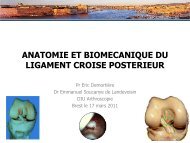

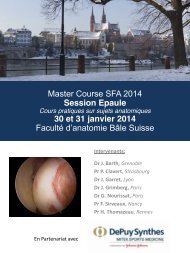
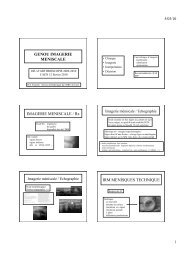
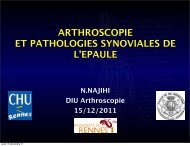
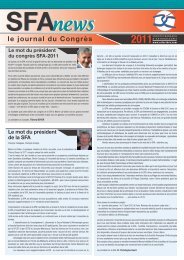
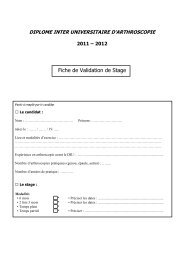

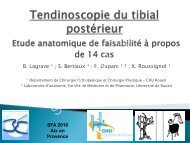
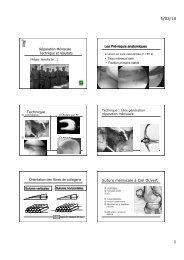
![Arthroscopie et traumatologie du genou [Mode de compatibilité]](https://img.yumpu.com/47899731/1/190x134/arthroscopie-et-traumatologie-du-genou-mode-de-compatibilite.jpg?quality=85)
